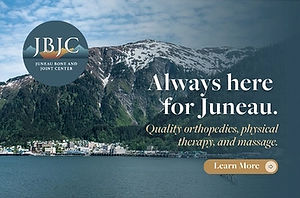New cruise ship docks in Juneau, Klawock make waves at Southeast Conference
- Daily Sitka Sentinel

- Sep 18, 2025
- 4 min read
Private docks planned by Huna Totem Corp., Goldbelt among projects that can expand economic and Indigenous culture opportunities, panelists say

By Anna Laffrey
Daily Sika Sentinel
News about burgeoning cruise ship docks in Juneau and Klawock took the fore of an hour-long panel with visitor industry leaders at the Southeast Conference annual meeting in Harrigan Centennial Hall on Tuesday.
The six panelists, including Sitka's City Administrator John Leach, also focused on means for regionwide and statewide visitor industry collaboration, the importance of representative community feedback, and historic preservation in Southeast communities.
Two cruise industry leaders on the panel described recent developments for new port facilities in Southeast Alaska led by Alaska Native Claims Settlement Act corporations.
Susan Bell, vice president of strategic initiatives at Huna Totem Corp., the ANSCA village corporation for the Southeast community of Hoonah, described the corp.'s partnership with Doyon Limited, a regional ANCSA corporation based in Fairbanks, to create a joint venture called Na-Dena’.
Na-Dena’ worked with Klawock Heenya Corp., Klawock's ANCSA village corporation, to establish the new cruise port in Klawock that opened last year.
Klawock welcomed its first passengers from six small to mid-sized cruise ships in 2024.
“We had six carefully curated tours,” Bell said. “We grew to about two dozen this year. … We're growing to about nearly 60 next year.”
Bell said the new Klawock port seems to work well for local residents because “it's a little bit remote from the community.
“It helps as a community in getting used to the cruise traffic and growing the businesses,” Bell said, noting that separation from the community’s downtown has also worked well at the corporation’s Icy Strait Point dock and facility in Hoonah.
Huna Totem Corp. is celebrating 21 years of operating Icy Strait Point, Bell said. The corporation expects that 700,000 passengers will disembark at ISP from cruise ships next year.
While Icy Strait Point began as a small venture, it's now recognized as a driver of Hoonah’s economy.
“There's been a decline in timber, decline in seafood, other (industries), and we want to create the economic opportunity so people can stay in the community,” Bell said.
Huna Totem Corp. also is working towards establishing a fifth cruise ship dock, and upland facilities, in downtown Juneau. The Juneau Assembly in April approved a tidelands lease for construction of the new dock in Gastineau Channel.
Goldbelt Inc., the urban ANCSA corporation for Juneau, also is shaking up the capital city’s cruise industry with plans to construct two new cruise ship docks and a new terminal facility on the back side of Douglas Island.
Steven Sahlender, executive vice president for the Alaska division of Goldbelt Inc., spoke about the corporation’s proposed development on 251 acres of Native corporation land.
The Douglas Island project, which would be focused on cultural tourism, is named “Goldbelt Aaní.” Sahlender said the corporation has been working on the project for almost 30 years.
“We're finally in a place economically that we can do a project like this, attract customers to help support our project and support the community at the same time,” Sahlender said.
Renée Limoge Reeve, the vice president of government and community relations for Cruise Lines International Association in Alaska, said that the new and proposed docks in Klawock and Juneau are opportunities for local business people.
Developers “need uplands at those places,” Reeve said. “They need things for people to do. So be that, if you're a business person, be that something, find that something that you're passionate about, and share your passion with the rest of the world who's dying to see Alaska.”
Heather Haugland, a vice president at McKinley Research Group, discussed how Southeast communities can use research to better understand and plan for tourism.
She encouraged community leaders to use research that is representative of their populations.
“It's too easy to put out an online survey where anyone can go on," Haugland said. "We have done these, and we have discovered that it's not necessarily representative of a community, so I just urge caution and research."
Also on the panel, Alaska State Historian and Deputy State Historic Preservation Officer Katie Ringsmuth spoke about how communities can cultivate successful heritage tourism programs.
Speaking to the theme of Tuesday's panel, “Creating a Community Experience,” city manager Leach said that “Sitka’s philosophy is that when residents thrive, the visitors experience authentic pride and a connection to the community that they're visiting.”
“To me, that means investing in the people and the place first, and that's what's going to bring the visitors here and let them have that valuable experience,” Leach said.
He said outdoor recreation opportunities, cultural heritage resources, community events and historical sites and programming are valuable for locals and visitors alike.
“When that community health and visitor appeal are intertwined, then it works out for everyone,” Leach said.
He also spoke about Port Communities of Alaska, an organization Sitka helped found that began during the COVID-19 pandemic.
The goal of PCOA “is to collaborate with other regional partners to ensure that we're supporting a healthy, well, managed and sustainable visitor economy,” the Sitka administrator said.
He said PCOA recently reviewed a number of recent public processes in Southeast Alaska related to the cruise ship industry and identified three major takeaways regarding community sentiment on tourism.
Those three takeaways are that communities are looking for steady growth in a calculated manner; visitors won’t enjoy overcrowded locations; and residents want local governments to do more to manage tourism.
Later in the panel, Leach said he thinks the city’s role in tourism involves supporting individuals looking to launch or grow their businesses; supporting Indigenous cultural tourism entrepreneurs and fostering partnerships with regional organizations involved in tourism.
• This article originally appeared in the Daily Sitka Sentinel.












